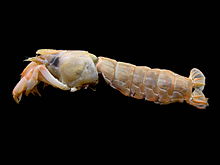Decapoda
| Decapoda Temporal range:
| |
|---|---|

| |
| From left to right: ). | |
| Scientific classification | |
| Domain: | Eukaryota |
| Kingdom: | Animalia |
| Phylum: | Arthropoda |
| Class: | Malacostraca |
| Superorder: | Eucarida |
| Order: | Decapoda Latreille, 1802 |
| Suborders | |
|
Dendrobranchiata | |
The Decapoda or decapods (literally "ten-footed") are an order of crustaceans within the class Malacostraca, and includes crabs, lobsters, crayfish, shrimp, and prawns. Most decapods are scavengers. The order is estimated to contain nearly 15,000 extant species in around 2,700 genera, with around 3,300 fossil species.[1] Nearly half of these species are crabs, with the shrimp (about 3,000 species) and Anomura including hermit crabs, porcelain crabs, squat lobsters (about 2500 species) making up the bulk of the remainder.[1] The earliest fossils of the group date to the Devonian.
Anatomy
Decapods can have as many as 38 appendages,

Evolution
A 2019
The cladogram below shows the internal relationships of Decapoda, from analysis by Wolfe et al. (2019).[3]
| Decapoda |
| |||||||||||||||||||||||||||
In the cladogram above, the
Classification
Classification within the order Decapoda depends on the structure of the gills and legs, and the way in which the larvae develop, giving rise to two suborders: Dendrobranchiata and Pleocyemata. The Dendrobranchiata consist of prawns, including many species colloquially referred to as "shrimp", such as the "white shrimp", Litopenaeus setiferus. The Pleocyemata include the remaining groups, including "true shrimp".[5] Those groups that usually walk rather than swim (Pleocyemata, excluding Stenopodidea and Caridea) form a clade called Reptantia.[6]
This classification to the level of superfamilies follows De Grave et al.[1]




Order Decapoda Latreille, 1802
- Suborder Dendrobranchiata Bate, 1888
- Penaeoidea Rafinesque, 1815
- Sergestoidea Dana, 1852
- Suborder Pleocyemata Burkenroad, 1963
- Infraorder Stenopodidea Bate, 1888
- Infraorder Caridea Dana, 1852
- ProcaridoideaChace & Manning, 1972
- GalatheacaridoideaVereshchaka, 1997
- PasiphaeoideaDana, 1852
- OplophoroideaDana, 1852
- AtyoideaDe Haan, 1849
- Bresilioidea Calman, 1896
- Nematocarcinoidea Smith, 1884
- PsalidopodoideaWood-....., 1874
- StylodactyloideaBate, 1888
- Campylonotoidea Sollaud, 1913
- Palaemonoidea Rafinesque, 1815
- Alpheoidea Rafinesque, 1815
- ProcessoideaOrtmann, 1896
- Pandaloidea Haworth, 1825
- PhysetocaridoideaChace, 1940
- Crangonoidea Haworth, 1825
- Infraorder Astacidea Latreille, 1802
- Enoplometopoideade Saint Laurent, 1988
- Nephropoidea Dana, 1852
- Astacoidea Latreille, 1802
- ParastacoideaHuxley, 1879
- Infraorder Glypheidea Winckler, 1882
- Glypheoidea Winckler, 1882
- Infraorder Axiidea de Saint Laurent, 1979b
- Infraorder Gebiidea de Saint Laurent, 1979
- Infraorder Achelata Scholtz & Richter, 1995
- Infraorder Polychelida Scholtz & Richter, 1995
- Infraorder Anomura MacLeay, 1838
- AegloideaDana, 1852
- Galatheoidea Samouelle, 1819
- Hippoidea Latreille, 1825a
- Chirostyloidea Ortmann, 1892
- LithodoideaSamouelle, 1819
- LomisoideaBouvier, 1895
- PaguroideaLatreille, 1802
- Infraorder BrachyuraLinnaeus, 1758
- Section Dromiacea De Haan, 1833
- Dromioidea De Haan, 1833
- HomolodromioideaAlcock, 1900
- Homoloidea De Haan, 1839
- Section Raninoida De Haan, 1839
- Section Cyclodorippoida Ortmann, 1892
- Section Eubrachyura de Saint Laurent, 1980
- Subsection Heterotremata Guinot, 1977
- AethroideaDana, 1851
- BellioideaDana, 1852
- BythograeoideaWilliams, 1980
- Calappoidea De Haan, 1833
- Cancroidea Latreille, 1802
- Carpilioidea Ortmann, 1893
- CheiragonoideaOrtmann, 1893
- CorystoideaSamouelle, 1819
- Dairoidea Serène, 1965
- Dorippoidea MacLeay, 1838
- Eriphioidea MacLeay, 1838
- Gecarcinucoidea Rathbun, 1904
- Goneplacoidea MacLeay, 1838
- HexapodoideaMiers, 1886
- Leucosioidea Samouelle, 1819
- Majoidea Samouelle, 1819
- OrithyioideaDana, 1852c
- Palicoidea Bouvier, 1898
- ParthenopoideaMacLeay,
- Pilumnoidea Samouelle, 1819
- Portunoidea Rafinesque, 1815
- Potamoidea Ortmann, 1896
- PseudothelphusoideaOrtmann, 1893
- Pseudozioidea Alcock, 1898
- RetroplumoideaGill, 1894
- Trapezioidea Miers, 1886
- TrichodactyloideaH. Milne-Edwards, 1853
- Xanthoidea MacLeay, 1838
- Subsection Thoracotremata Guinot, 1977
- CryptochiroideaPaul'son, 1875
- Grapsoidea MacLeay, 1838
- Ocypodoidea Rafinesque, 1815
- PinnotheroideaDe Haan, 1833
- Subsection Heterotremata Guinot, 1977
- Section Dromiacea De Haan, 1833
See also
References
- ^ Raffles Bulletin of Zoology. Suppl. 21: 1–109. Archived from the original(PDF) on 2011-06-06.
- ^ a b c "Decapoda characters and anatomy". University of Bristol: Decapoda characters. Archived from the original on 10 November 2013. Retrieved 11 December 2017.
- ^ PMID 31014217.
- )
- ISBN 978-1-57808-529-3.
- .
External links
 Data related to Decapoda at Wikispecies
Data related to Decapoda at Wikispecies- Decapod Crustacea "Tree of Life" page at the Natural History Museum of Los Angeles County
- Decapoda at Curlie
